Development and Evaluation of a Deep Learning Based System to Predict District-Level Maize Yields in Tanzania
Abstract
1. Introduction
2. Materials and Methods
2.1. Collection of Data
2.2. Requirements Analysis
2.3. Tanzania Districts and Crop Seasons
2.4. Software Development Process
2.5. Deep Learning Data
2.5.1. Terra MODIS Satellite NDVI
2.5.2. Climate Data
2.5.3. Historical Maize Yield Data
2.5.4. Input Data
2.5.5. Correlation of Input Data
2.6. Deep Learning Models
2.6.1. Architecture of Deep Learning Models
- Preprocessing: Both the unimodal and bimodal deep learning models need to be trained with training data to correctly predict the maize yield and tested with test data to evaluate their effectiveness in predicting maize yields. In order to train and test the models, each data point has to be labelled. In this study, the labels are maize yields at the end of crop seasons. We labeled all district data points with their corresponding end-of-season maize yields as shown in Table 1. Because deep learning models only process numerical data as input; therefore, we transformed all data points into the float32 format. The unimodal training set contained 371 data points (2597 timesteps of input data), while the unimodal test set contained 53 data points (371 timesteps of input data). The bimodal training set contained 245 data points (2205 timesteps of input data), while the bimodal test set contained 35 data points (315 timesteps of input data). All of the datasets are provided in the Supplementary Materials.
- LSTM layers: To learn the patterns in the input data points and correctly predict maize yields, we chose to use an LSTM network (a type of RNN) because it performs highly in processing data which have sequences such as time series data and data containing text. The proposed LSTM network is used to process the data points, timestep by timestep, by looping over the timesteps of the input data points at the same time keeping a memory (state) of the timestep data that it has processed. While doing this, the LSTM network saves the information with the purpose of using it later for preventing older signals from gradually vanishing (vanishing gradients) which results into better input data understanding. LSTM layer has several arguments one of which is output-dimensionality (number of units), indicating LSTM layer dimensionality for the output space. Usually, sequence batches are processed by the LSTM layer which takes the 3D tensor with the shape (batch-size, timesteps, input-features) as input and then returns a 3D tensor with the shape (batch-size, timesteps, output-features), like in the first LSTM layer in our deep learning model architecture or a 2D tensor with the shape (batch-size, output-features), like in the second LSTM layer in our deep learning model architecture]. The batch-size is used to indicate the amount of samples that has to be processed in every batch, input-features is used to indicate the input feature space dimensionality, timesteps indicates the length of sequence, and output-featuresis used to indicate the output feature space dimensionality.
- Dense layer: Trained to output a single numerical value as the predicted maize yield.
2.6.2. Deep Learning Loss Function (MSE)
2.6.3. Deep Learning Evaluation Metric (MAPE)
2.7. K-Fold Cross-Validation
2.8. Design of System
2.8.1. Architecture of System
2.8.2. Database Design
2.9. Prototype Implementation and Testing
3. Results
3.1. Hyperparameter Tuning Experiments
3.2. Final Training Experiments
3.3. Prediction Accuracy on Test Sets and Comparisons
4. Discussion and Conclusions
4.1. Discussion
4.1.1. Improved Accessibility
4.1.2. Deep Learning Models Impact on Processing Combined NDVI and Climate Data
4.1.3. Study Limitations
4.1.4. Major Contributions
- Completed and ready-to-use deep learning-based information system that allows farmers, cooperative union officers, district officers, and ministry officers in Tanzania to forecast end-of-season district maize yields via SMS and Web system.
- Novel method of using SMS to query deep learning models using MySQL triggers.
- Deep learning architectures that can also be adopted and used by other researchers.
- Deep learning datasets with prediction data from almost all districts in Tanzania, which can be used by other researchers.
- Performance evaluation findings that fill the existing information gap on effectiveness of deep learning models in predicting crop yields in Tanzania.
4.2. Conclusions
Supplementary Materials
Author Contributions
Funding
Institutional Review Board Statement
Informed Consent Statement
Data Availability Statement
Conflicts of Interest
References
- URT [United Republic of Tanzania]: National Agriculture Policy. Available online: http://extwprlegs1.fao.org/docs/pdf/tan141074.pdf (accessed on 30 August 2022).
- The World Bank: Rural Population. Available online: https://data.worldbank.org/indicator/SP.RUR.TOTL.ZS?locations=TZ (accessed on 30 August 2022).
- URT [United Republic of Tanzania]: Household Budget Survey (HBS), 2011/12—Key Findings Report. Available online: https://www.nbs.go.tz/index.php/en/census-surveys/poverty-indicators-statistics/household-budget-survey-hbs/148-household-budget-survey-hbs-2011-12-key-findings-report (accessed on 30 August 2022).
- USDA [United States Department of Agriculture]: Tanzania—United Republic of, Grain and Feed Annual 2019 Tanzania Corn, Wheat and Rice Report. Available online: https://apps.fas.usda.gov/newgainapi/api/report/downloadreportbyfilename?filename=Grain%20and%20Feed%20Annual_Dar%20es%20Salaam_Tanzania%20-%20United%20Republic%20of_4-9-2019.pdf (accessed on 30 August 2022).
- Chen, Y.; Lee, W.S.; Gan, H.; Peres, N.; Fraisse, C.; Zhang, Y.; He, Y. Strawberry Yield Prediction Based on a Deep Neural Network Using High-Resolution Aerial Orthoimages. Remote Sens. 2019, 11, 1584. [Google Scholar] [CrossRef]
- Fernandez-Beltran, R.; Baidar, T.; Kang, J.; Pla, F. Rice-Yield Prediction with Multi-Temporal Sentinel-2 Data and 3D CNN: A Case Study in Nepal. Remote Sens. 2021, 13, 1391. [Google Scholar] [CrossRef]
- Danilevicz, M.F.; Bayer, P.E.; Boussaid, F.; Bennamoun, M.; Edwards, D. Maize Yield Prediction at an Early Developmental Stage Using Multispectral Images and Genotype Data for Preliminary Hybrid Selection. Remote Sens. 2021, 13, 3976. [Google Scholar] [CrossRef]
- Wang, Y.; Zhang, Z.; Feng, L.; Du, Q.; Runge, T. Combining Multi-Source Data and Machine Learning Approaches to Predict Winter Wheat Yield in the Conterminous United States. Remote Sens. 2020, 12, 1232. [Google Scholar] [CrossRef]
- Wang, L.; Ma, H.; Li, J.; Gao, Y.; Fan, L.; Yang, Z.; Yang, Y.; Wang, C. An automated extraction of small- and middle-sized rice fields under complex terrain based on SAR time series: A case study of Chongqing. Comput. Electron. Agric. 2022, 200, 107232. [Google Scholar] [CrossRef]
- Sepp, H.; Jürgen, S. Long short-term memory. J. Neural Comput. 1997, 9, 1735–1780. [Google Scholar]
- Alibabaei, K.; Gaspar, P.D.; Lima, T.M. Crop Yield Estimation Using Deep Learning Based on Climate Big Data and Irrigation Scheduling. Energies 2021, 14, 3004. [Google Scholar] [CrossRef]
- Haider, S.A.; Naqvi, S.R.; Akram, T.; Umar, G.A.; Shahzad, A.; Sial, M.R.; Khaliq, S.; Kamran, M. LSTM Neural Network Based Forecasting Model for Wheat Production in Pakistan. Agronomy 2019, 9, 72. [Google Scholar] [CrossRef]
- Cho, W.; Kim, S.; Na, M.; Na, I. Forecasting of Tomato Yields Using Attention-Based LSTM Network and ARMA Model. Electronics 2021, 10, 1576. [Google Scholar] [CrossRef]
- Zhang, L.; Zhang, Z.; Luo, Y.; Cao, J.; Tao, F. Combining Optical, Fluorescence, Thermal Satellite, and Environmental Data to Predict County-Level Maize Yield in China Using Machine Learning Approaches. Remote Sens. 2020, 12, 21. [Google Scholar] [CrossRef]
- Nevavuori, P.; Narra, N.; Linna, P.; Lipping, T. Crop Yield Prediction Using Multitemporal UAV Data and Spatio-Temporal Deep Learning Models. Remote Sens. 2020, 12, 4000. [Google Scholar] [CrossRef]
- Sun, J.; Di, L.; Sun, Z.; Shen, Y.; Lai, Z. County-Level Soybean Yield Prediction Using Deep CNN-LSTM Model. Sensors 2019, 19, 4363. [Google Scholar] [CrossRef] [PubMed]
- The World Bank: Mobile Cellular Subscriptions (per 100 People)—Tanzania. Available online: https://data.worldbank.org/indicator/IT.CEL.SETS.P2?locations=TZ (accessed on 30 August 2022).
- Tende, I.G.; Kubota, S.; Yamaba, H.; Aburada, K.; Okazaki, N. Evaluation of farmers market information system to connect with some social stakeholders. J. Inf. Process. 2018, 26, 247–256. [Google Scholar]
- Wang, J.-H.; Liu, T.-W.; Luo, X. Combining Post Sentiments and User Participation for Extracting Public Stances from Twitter. Appl. Sci. 2020, 10, 8035. [Google Scholar] [CrossRef]
- Al-Laith, A.; Shahbaz, M.; Alaskar, H.F.; Rehmat, A. AraSenCorpus: A Semi-Supervised Approach for Sentiment Annotation of a Large Arabic Text Corpus. Appl. Sci. 2021, 11, 2434. [Google Scholar] [CrossRef]
- Yasar, H.; Kilimci, Z.H. US Dollar/Turkish Lira Exchange Rate Forecasting Model Based on Deep Learning Methodologies and Time Series Analysis. Symmetry 2021, 12, 1553. [Google Scholar] [CrossRef]
- Feed the Future (U.S. Government’s Global Hunger and Food Security Initiative): Maize Production Manual for Smallholder Farmers in Tanzania. Available online: https://cgspace.cgiar.org/bitstream/handle/10568/109806/Maize%20production%20manual%20for%20smallholder%20farmers%20in%20Tanzania.pdf?sequence=1 (accessed on 30 August 2022).
- United Nations World Food Programme: Special Report, FAO/WFP Crop and Food Supply Assessment Mission to the United Republic of Tanzania. Available online: https://www.fao.org/3/w7958e/w7958e00.htm (accessed on 30 August 2022).
- NASA Eath Observatory: Normalized Difference Vegetation Index (NDVI). Available online: https://earthobservatory.nasa.gov/features/MeasuringVegetation/measuring_vegetation_2.php#:~:text=Normalized%20Difference%20Vegetation%20Index%20(NDVI,up%20the%20spectrum%20of%20sunlight (accessed on 30 August 2022).
- NASA TERRA: Moderate Resolution Imaging Spectroradiometer. Available online: https://terra.nasa.gov/about/terra-instruments/modis (accessed on 30 August 2022).
- NASA: GIMMS Global Agricultural Monitoring. Available online: https://glam1.gsfc.nasa.gov/ (accessed on 30 August 2022).
- Abatzoglou, J.; Dobrowski, S.; Parks, S.; Hegewisch, K.C. TerraClimate, a high-resolution global dataset of monthly climate and climatic water balance from 1958-2015. Sci. Data 2018, 5, 170191. [Google Scholar] [CrossRef]
- Google: Google Earth Engine. Available online: https://earthengine.google.com/ (accessed on 30 August 2022).
- Climate Engine: Research App. Available online: https://app.climateengine.com/climateEngine (accessed on 30 August 2022).
- FAO [The Food and Agriculture Organization]: Global Administrative Unit Layers (GAUL). Available online: https://data.review.fao.org/map/catalog/srv/api/records/9c35ba10-5649-41c8-bdfc-eb78e9e65654 (accessed on 30 August 2022).
- URT [United Republic of Tanzania], Ministry of Agriculture: TAKWIMU. Available online: https://www.kilimo.go.tz/resources/category/takwimu (accessed on 30 August 2022).
- Wikipedia: Pearson Correlation Coefficient. Available online: https://en.wikipedia.org/wiki/Pearson_correlation_coefficient (accessed on 30 August 2022).
- Keras: Adam Optimizer. Available online: https://keras.io/api/optimizers/adam/ (accessed on 30 August 2022).
- Refaeilzadeh, P.; Tang, L.; Liu, H. Cross-Validation. In Encyclopedia of Database Systems; Liu, L., Özsu, M.T., Eds.; Springer: Boston, MA, USA, 2016. [Google Scholar]
- OZEKI NG SMS Gateway. Available online: https://ozekisms.com/ (accessed on 30 August 2022).
- Node.js Organization: Node.js v18.8.0 Documentation, Child Process. Available online: https://nodejs.org/api/child_process.html#child_processspawncommand-args-options (accessed on 30 August 2022).
- MySQL Workbench. Available online: https://www.mysql.com/products/workbench/ (accessed on 30 August 2022).
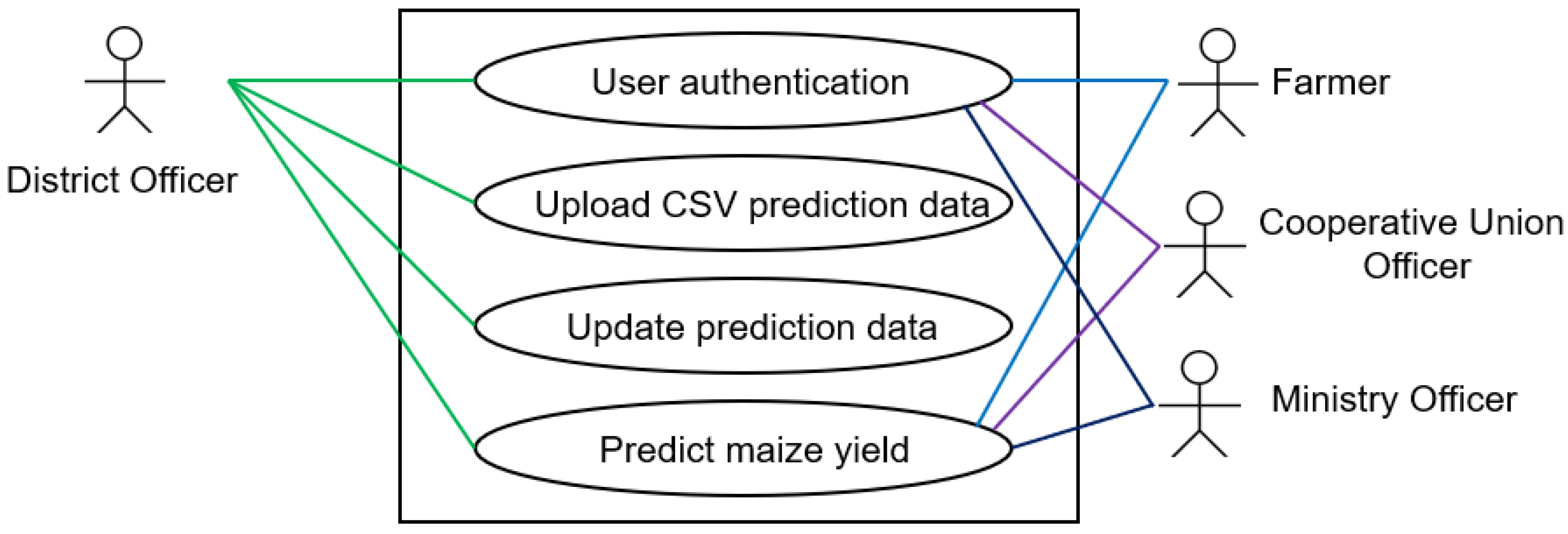
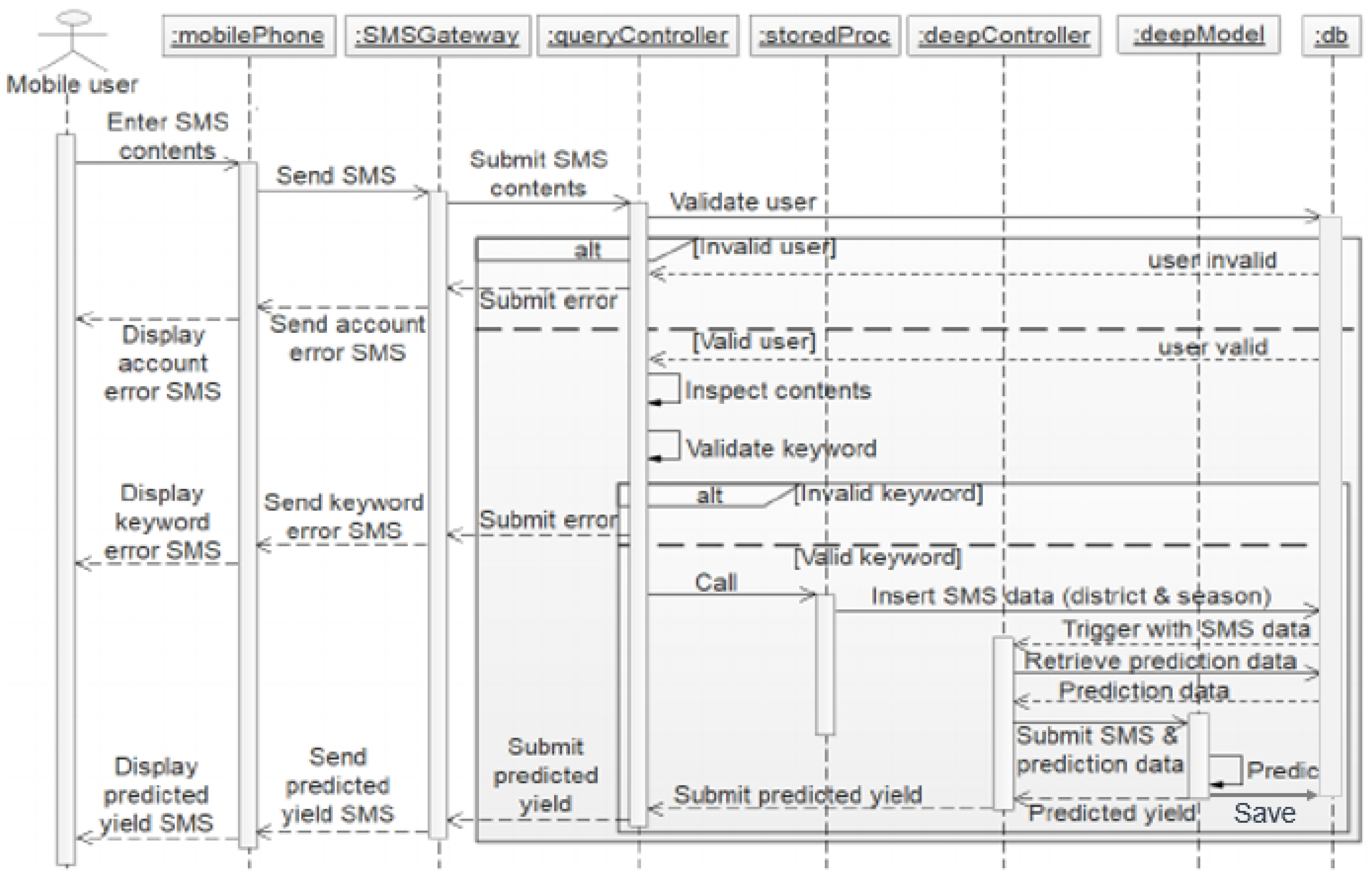
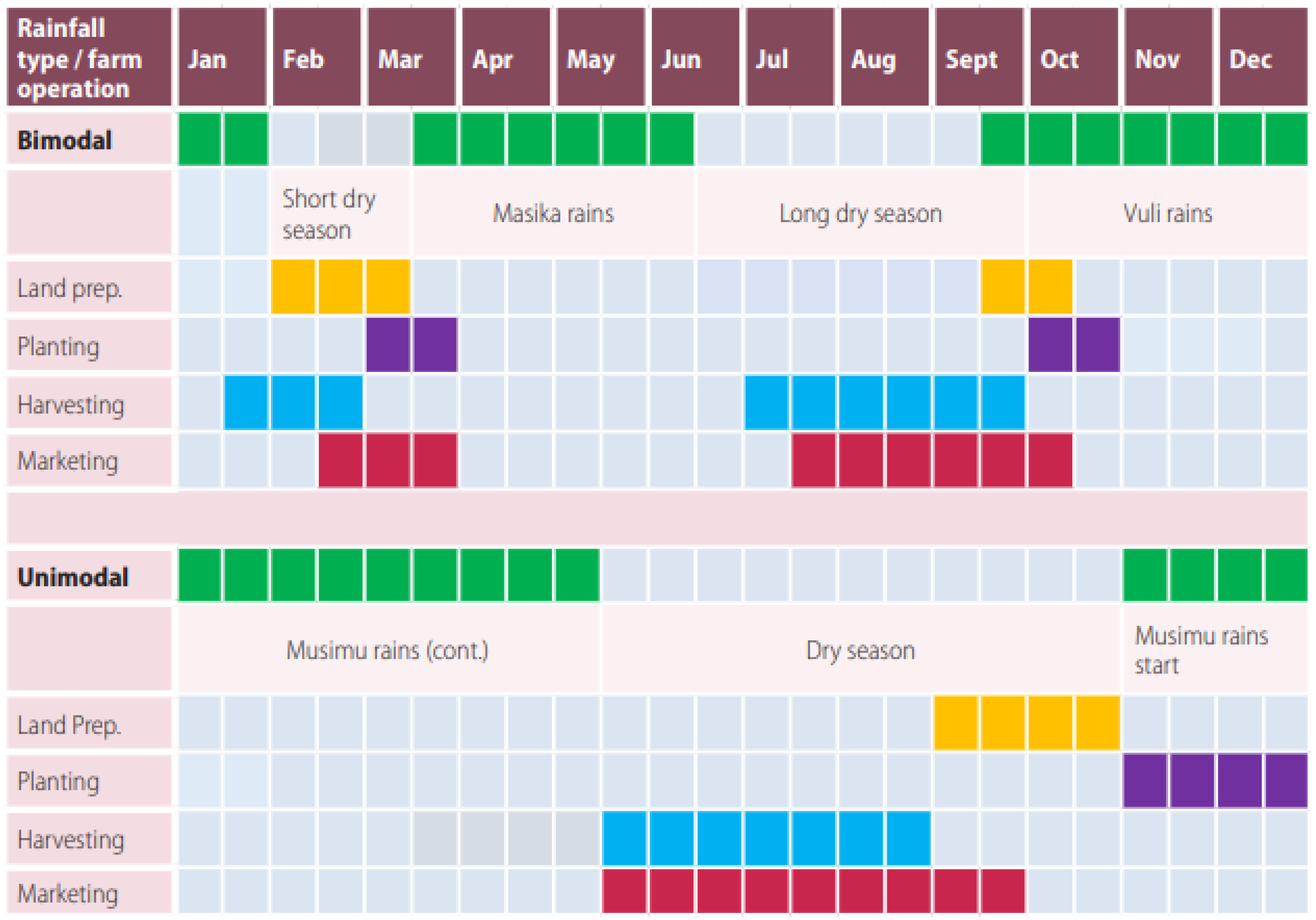

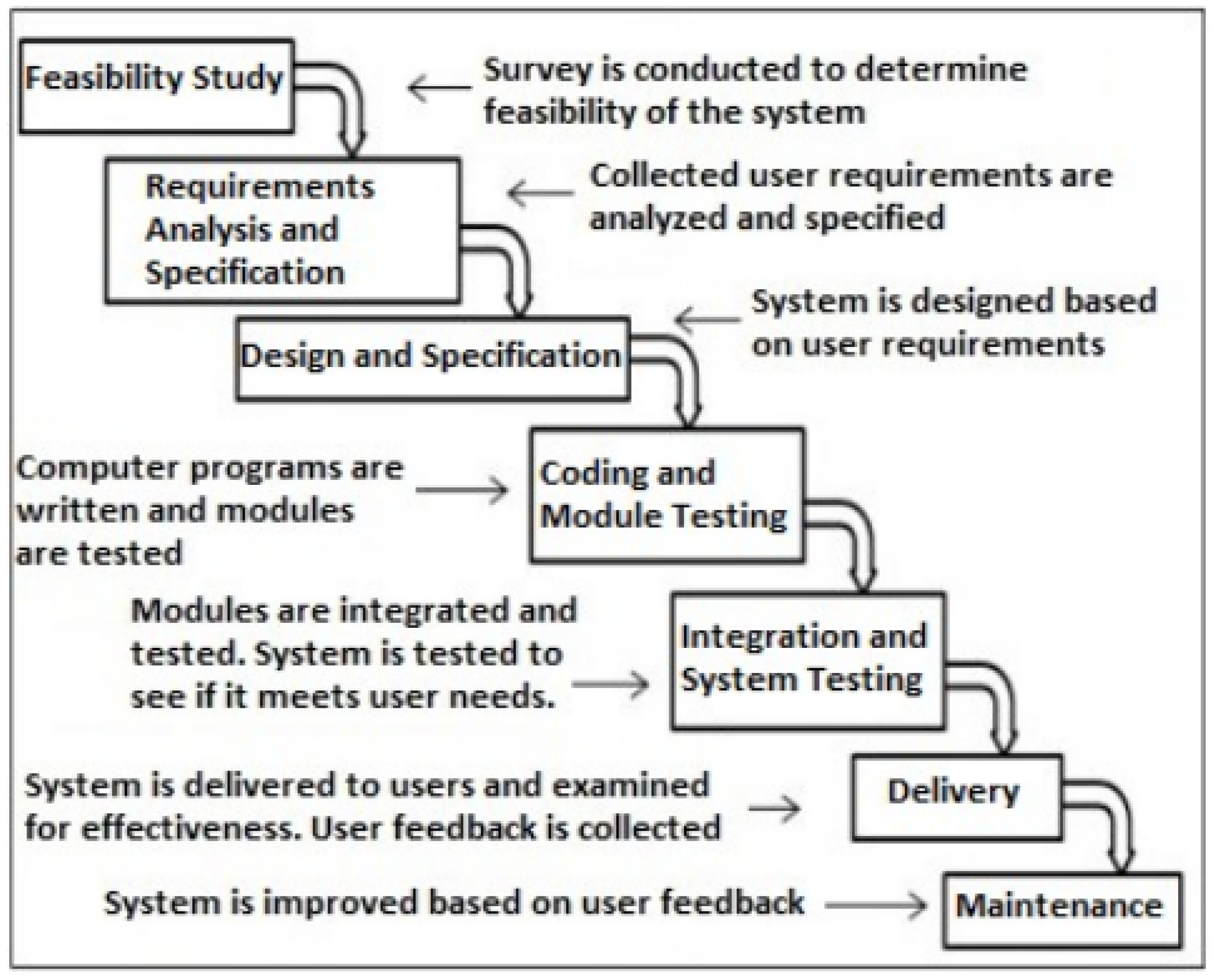
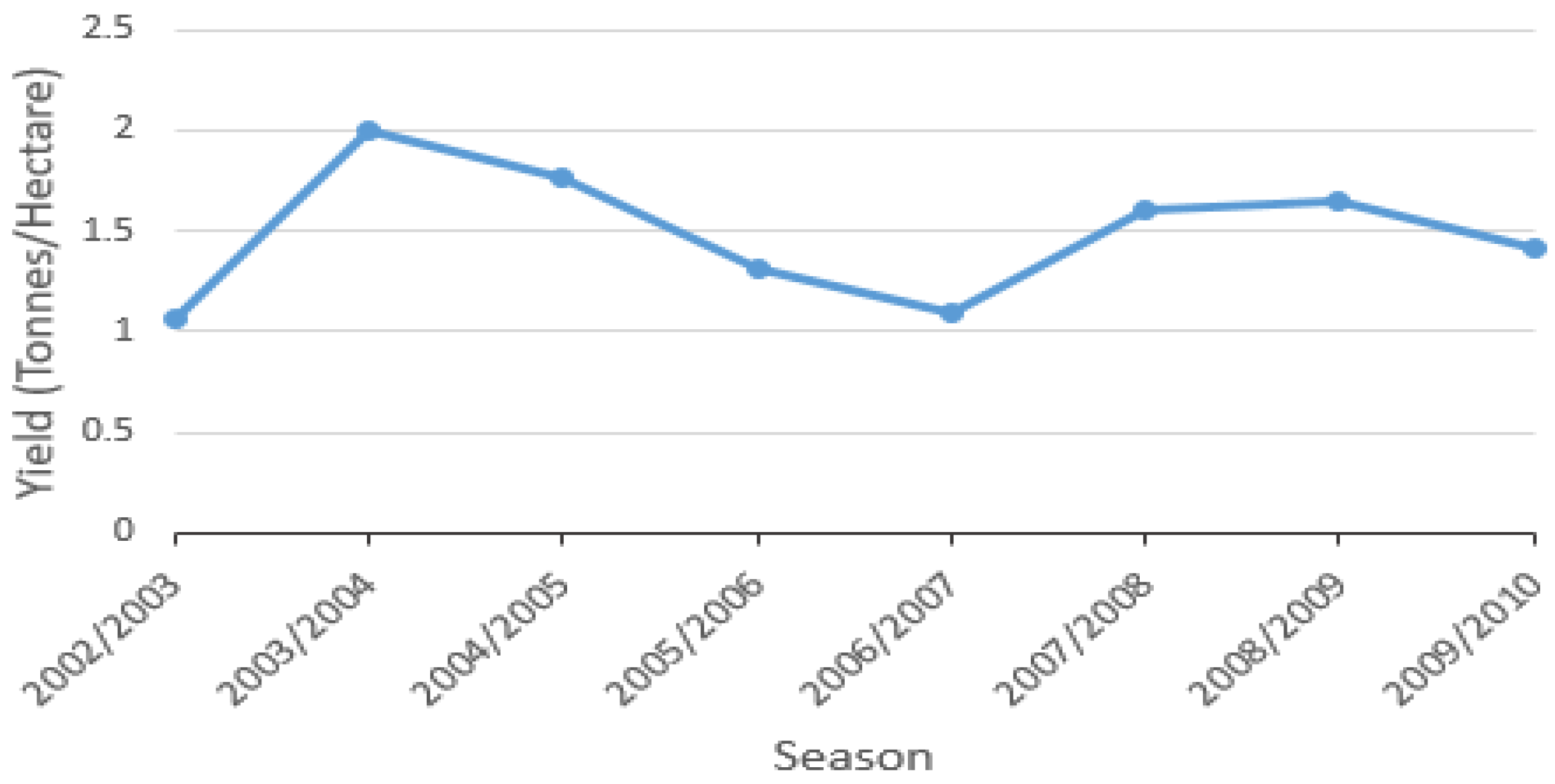
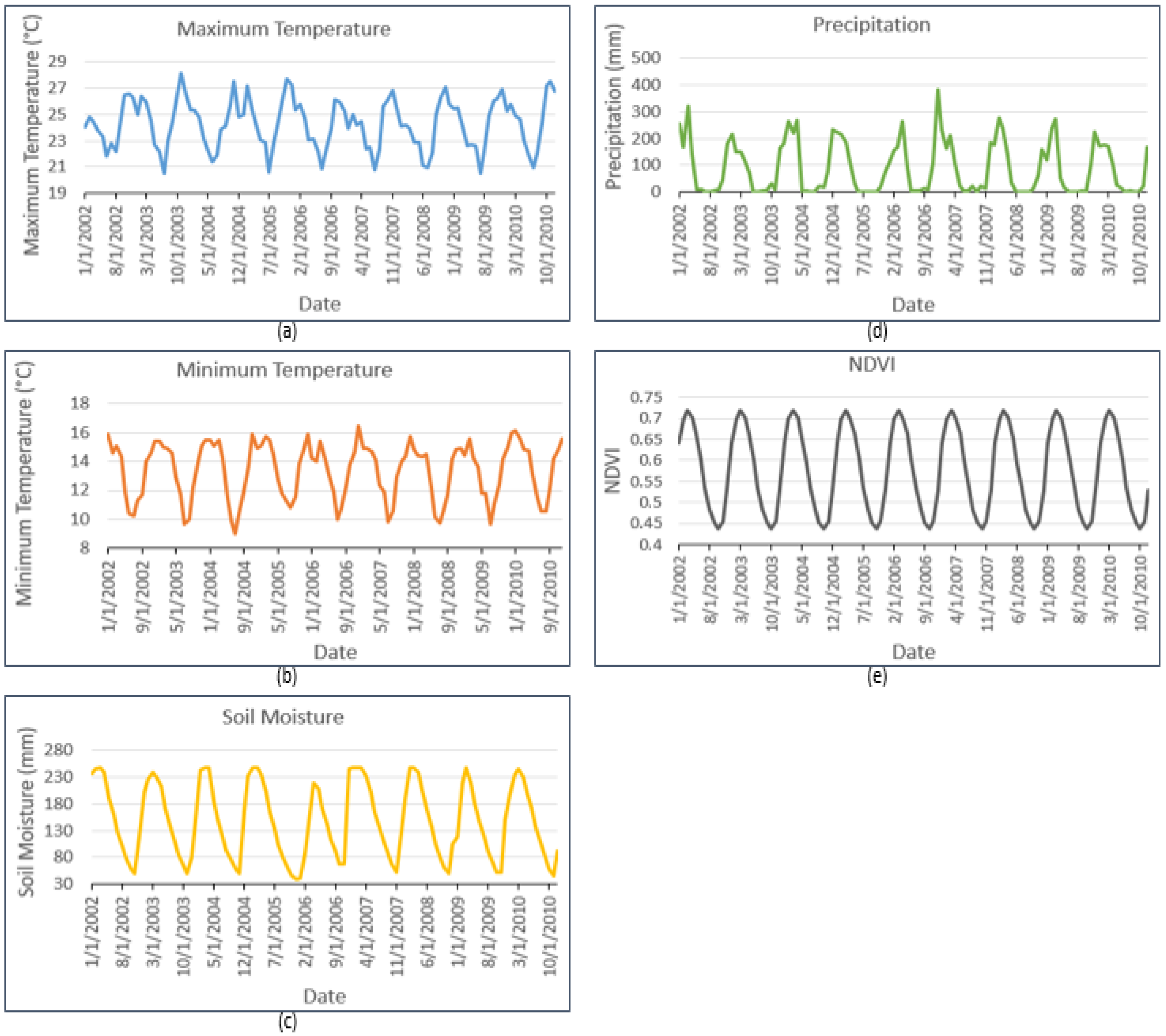
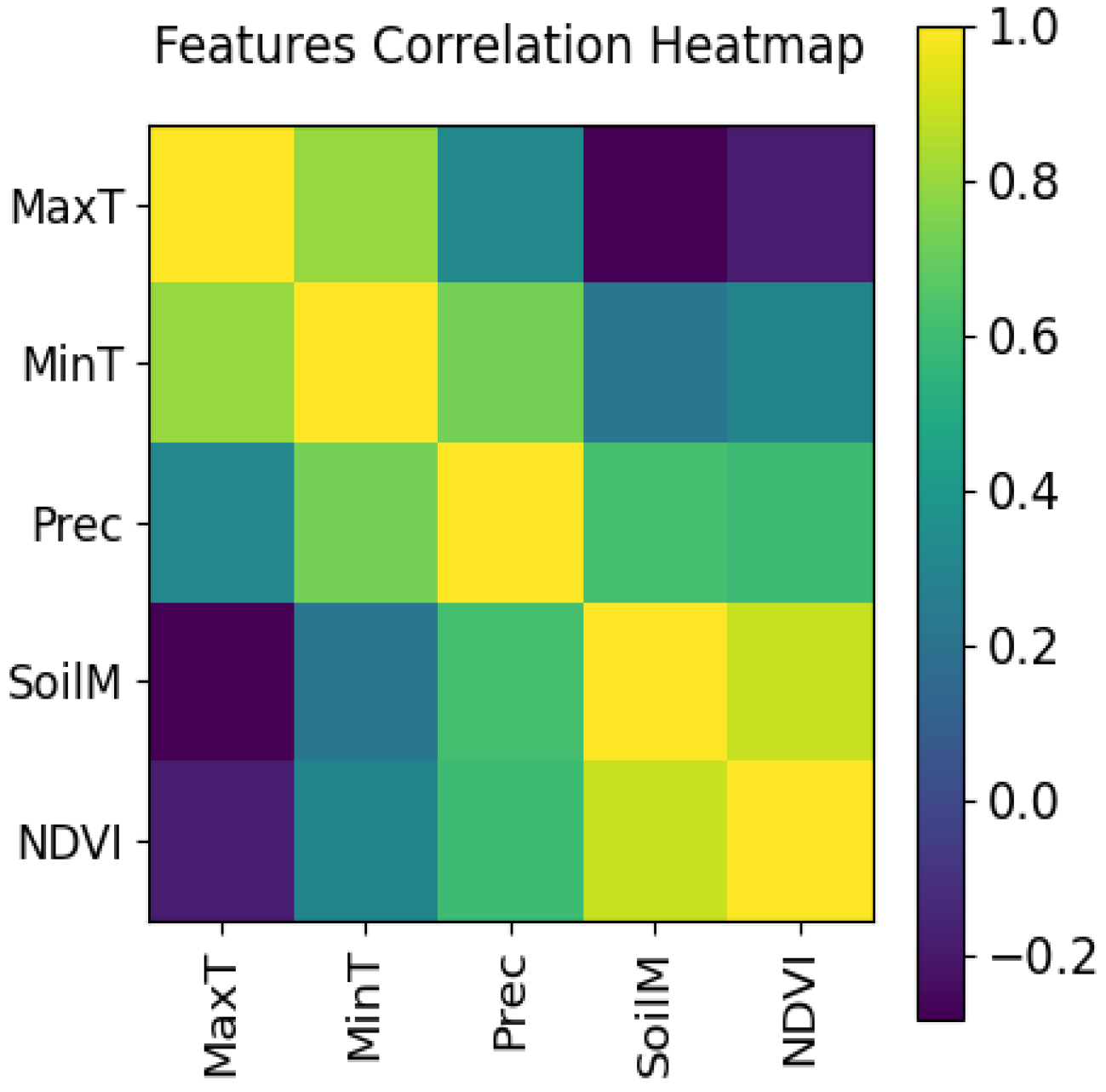

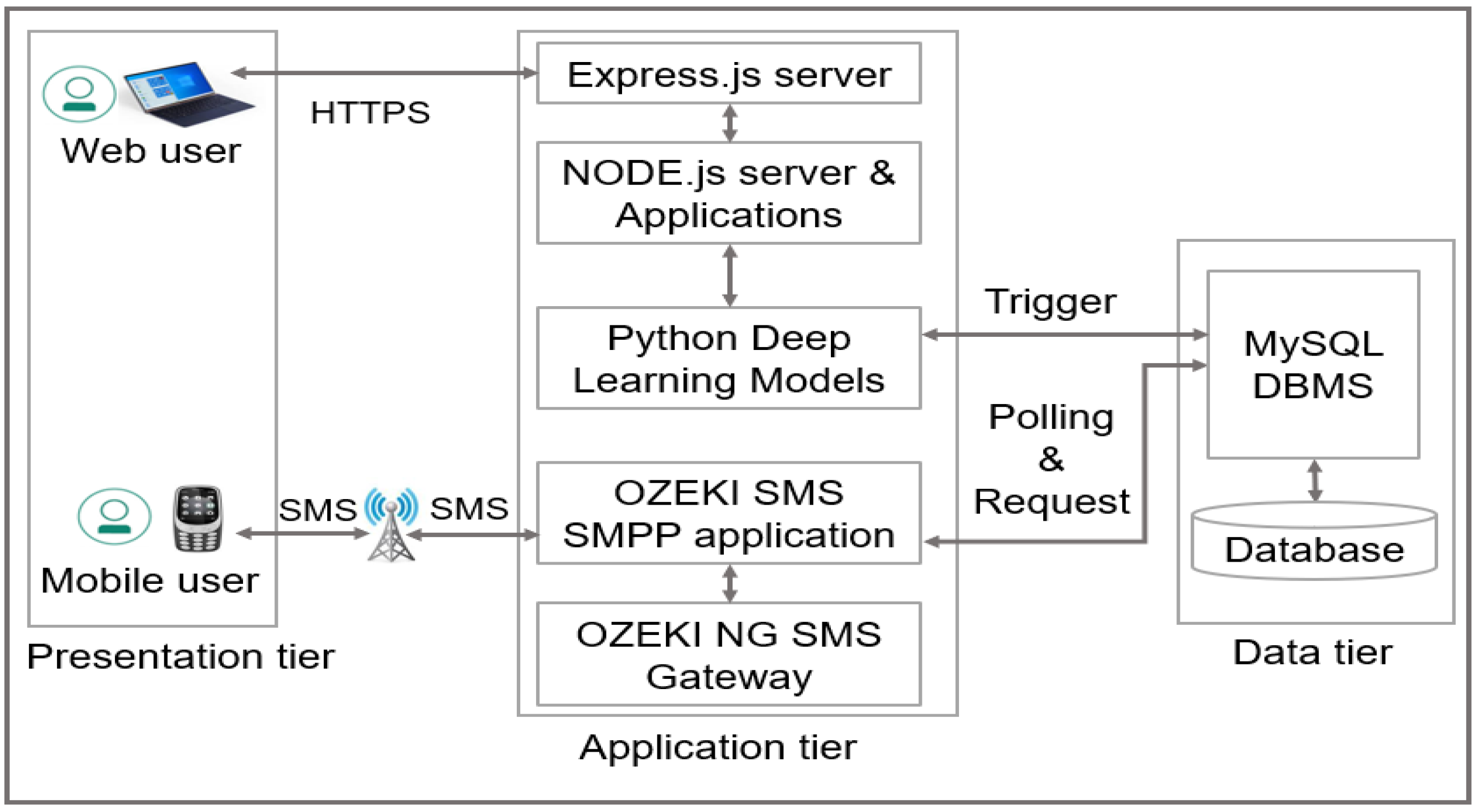
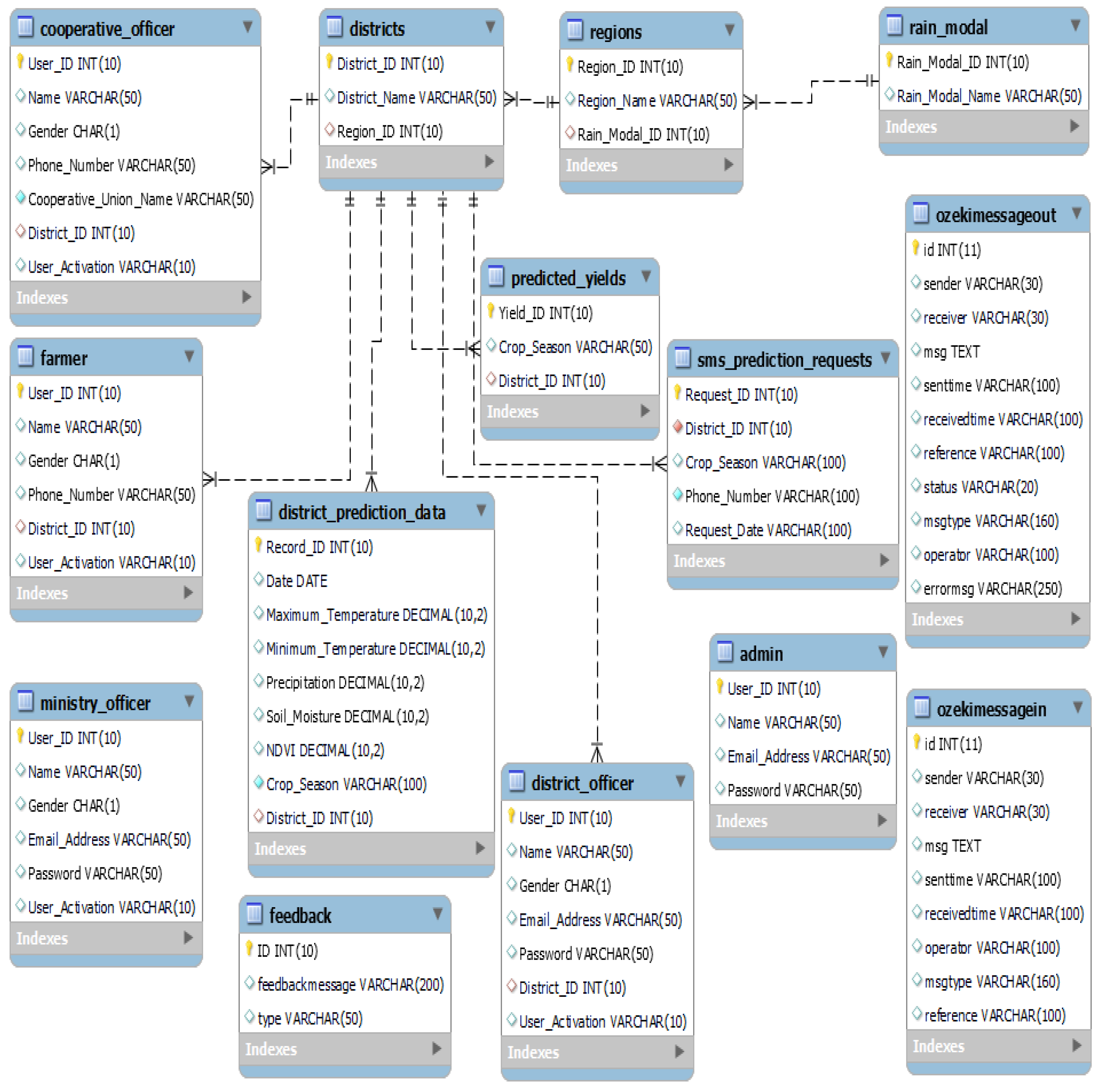


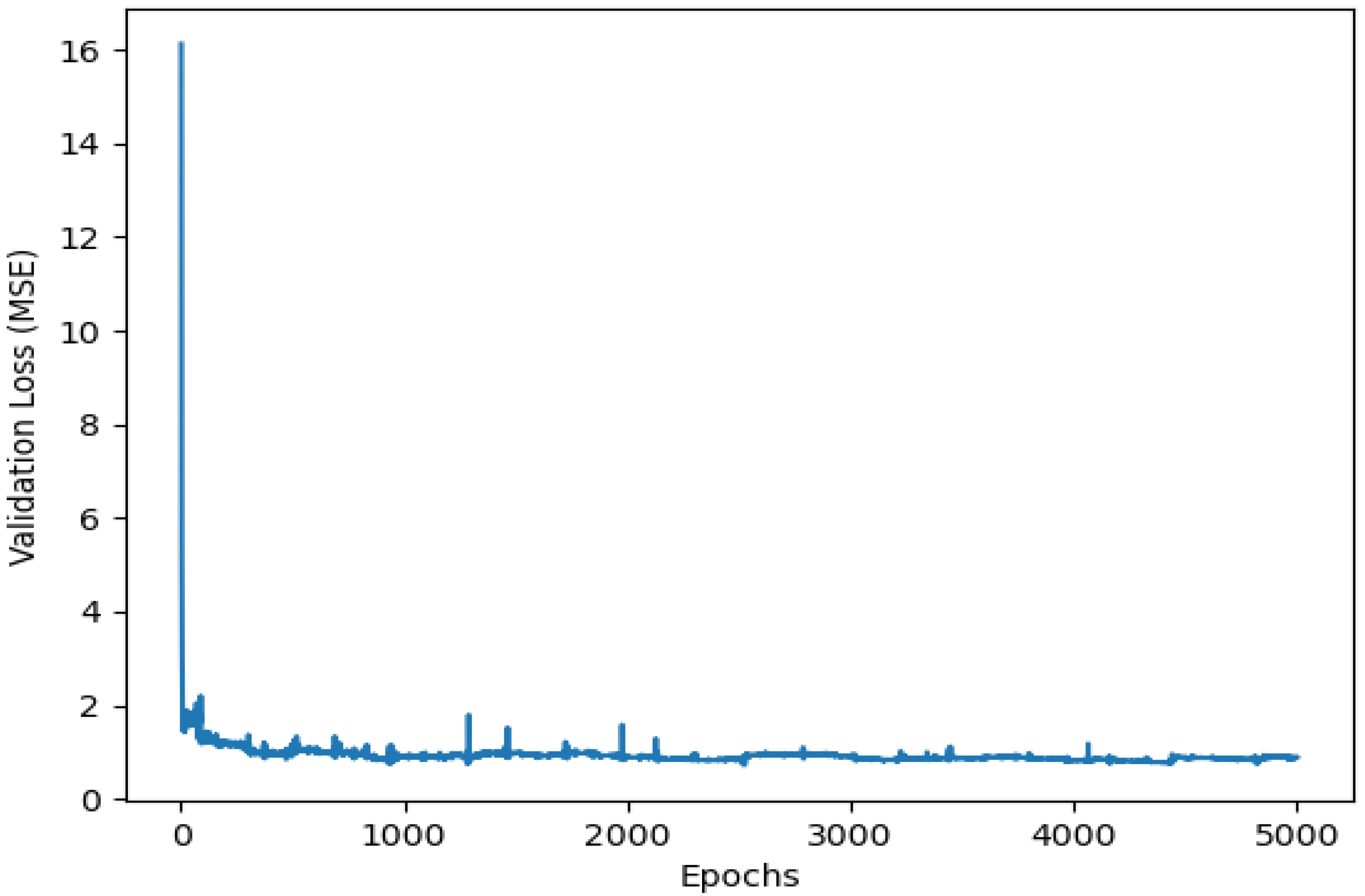
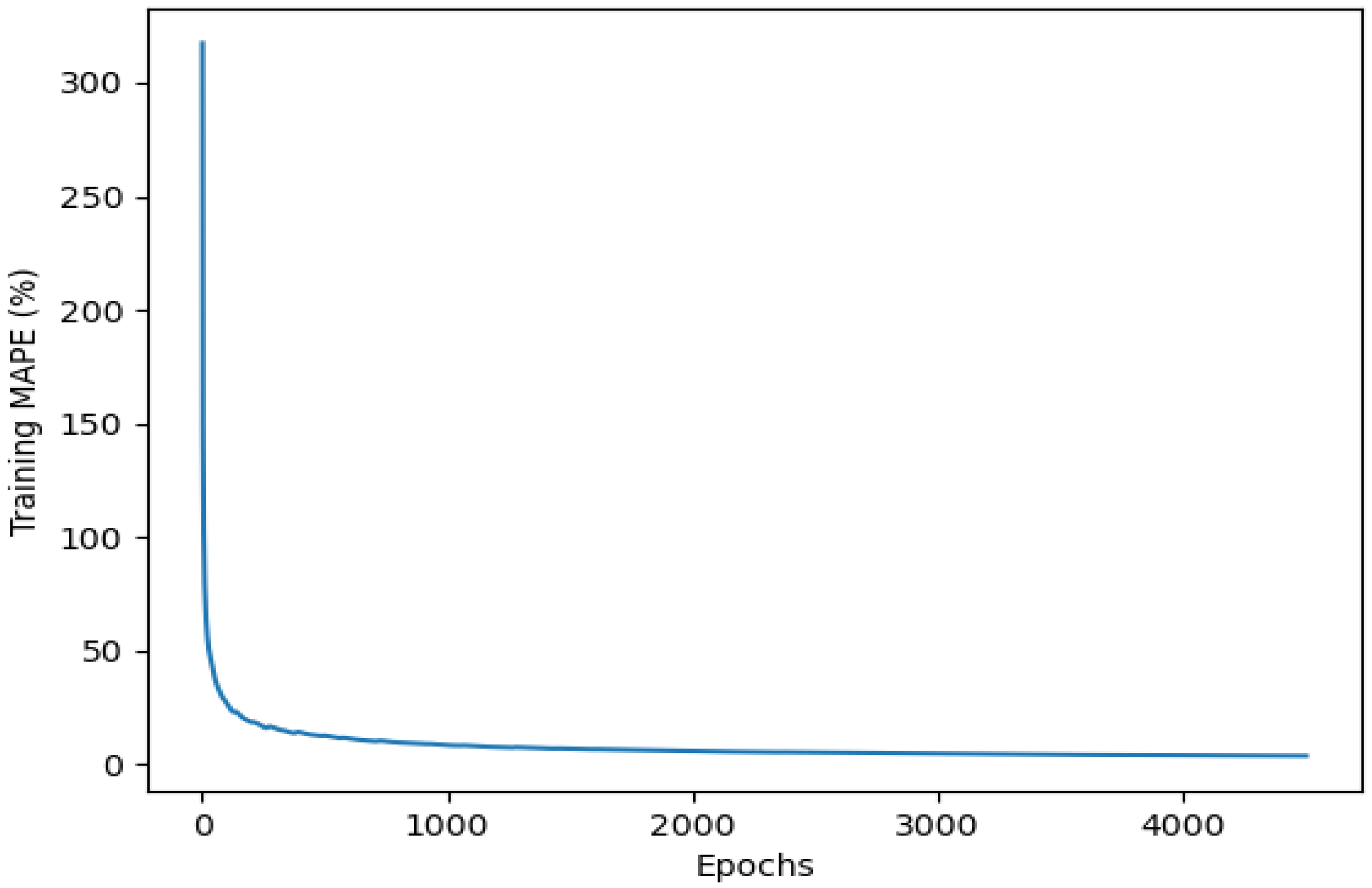

| Rainfall Modal | Region | Districts |
|---|---|---|
| Unimodal | Dodoma | Kondoa and Mpwapwa |
| Iringa | Ludewa, Makete, and Mufindi | |
| Lindi | Kilwa, Lindi Rural, Lindi Urban, Liwale, Nachingwea, and Ruangwa | |
| Mbeya | Chunya, Kyela, Mbarali, Mbeya Rural, and Mbeya Urban | |
| Songwe | Ileje and Mbozi | |
| Morogoro | Kilombero, Kilosa, Morogoro Rural, Mvomero, and Ulanga | |
| Mtwara | Masasi, Mtwara Rural, Mtwara Urban, Newala, and Tandahimba | |
| Rukwa | Nkasi, Sumbawanga Rural, and Sumbawang Urban | |
| Ruvuma | Mbinga, Namtumbo, Songea Rural, Songea Urban, and Tunduru | |
| Simiyu | Bariadi, Maswa, and Meatu | |
| Shinyanga | Kahama, Kishapu, Shinyanga Rural, and Shinyanga Urban | |
| Geita | Bukombe | |
| Singida | Iramba, Manyoni, and Singida Rural | |
| Tabora | Igunga, Nzega, Sikonge, Tabora Urban, Urambo, and Uyui | |
| Bimodal | Arusha | Karatu, Ngorongoro, and Monduli |
| Dar es Salaam | Ilala, Temeke, and Kinondoni | |
| Kagera | Muleba | |
| Kigoma | Kasulu, Kibondo, and Kigoma Rural | |
| Kilimanjaro | Hai, Moshi Rural, Mwanga, Rombo, and Same | |
| Manyara | Hanang, Kiteto, and Simanjiro | |
| Mara | Bunda and Serengeti | |
| Mwanza | Ilemela, Kwimba, Magu, Misungwi, Sengerema, and Ukerewe | |
| Pwani | Bagamoyo, Kisarawe, Mafia, Mkuranga, and Rufiji | |
| Tanga | Handeni, Lushoto, Pangani, and Tanga |
| District | Date | Max-Temp (°C) | Min-Temp (°C) | Precipitation (mm) | Soil-Moisture (mm) | NDVI | Yield (Tonne/Hectare) |
|---|---|---|---|---|---|---|---|
| Liwale | 11/1/2002 | 31.02 | 22.31 | 107.5 | 30.68 | 0.48 | |
| 12/1/2002 | 30.92 | 22.28 | 140.84 | 50.02 | 0.57 | ||
| 1/1/2003 | 29.66 | 22.66 | 170.39 | 99.03 | 0.7 | ||
| 2/1/2003 | 30.28 | 22.38 | 132 | 119.28 | 0.76 | ||
| 3/1/2003 | 30.47 | 22.34 | 109.86 | 115.9 | 0.78 | ||
| 4/1/2003 | 29.6 | 21.39 | 82.24 | 103.64 | 0.78 | ||
| 5/1/2003 | 28.3 | 20.1 | 37.03 | 81.24 | 0.75 | 0.32 | |
| Kiteto | 9/1/2002 | 27.07 | 13.57 | 15.2 | 14.67 | 0.31 | |
| 10/1/2002 | 28.78 | 15.16 | 48.02 | 12.87 | 0.29 | ||
| 11/1/2002 | 29.5 | 16.54 | 36.59 | 11.48 | 0.31 | ||
| 12/1/2002 | 29.07 | 16.81 | 142.17 | 41.15 | 0.38 | ||
| 1/1/2003 | 29.13 | 16.4 | 50.58 | 27.17 | 0.52 | ||
| 3/1/2003 | 29.6 | 16.41 | 56.66 | 17.35 | 0.61 | ||
| 4/1/2003 | 28.82 | 17.06 | 46.35 | 14.83 | 0.65 | ||
| 5/1/2003 | 25.53 | 15.52 | 83.55 | 18.73 | 0.63 | ||
| 6/1/2003 | 25.39 | 14.11 | 7.25 | 14.7 | 0.52 | 0.53 |
Disclaimer/Publisher’s Note: The statements, opinions and data contained in all publications are solely those of the individual author(s) and contributor(s) and not of MDPI and/or the editor(s). MDPI and/or the editor(s) disclaim responsibility for any injury to people or property resulting from any ideas, methods, instructions or products referred to in the content. |
© 2023 by the authors. Licensee MDPI, Basel, Switzerland. This article is an open access article distributed under the terms and conditions of the Creative Commons Attribution (CC BY) license (https://creativecommons.org/licenses/by/4.0/).
Share and Cite
Tende, I.G.; Aburada, K.; Yamaba, H.; Katayama, T.; Okazaki, N. Development and Evaluation of a Deep Learning Based System to Predict District-Level Maize Yields in Tanzania. Agriculture 2023, 13, 627. https://doi.org/10.3390/agriculture13030627
Tende IG, Aburada K, Yamaba H, Katayama T, Okazaki N. Development and Evaluation of a Deep Learning Based System to Predict District-Level Maize Yields in Tanzania. Agriculture. 2023; 13(3):627. https://doi.org/10.3390/agriculture13030627
Chicago/Turabian StyleTende, Isakwisa Gaddy, Kentaro Aburada, Hisaaki Yamaba, Tetsuro Katayama, and Naonobu Okazaki. 2023. "Development and Evaluation of a Deep Learning Based System to Predict District-Level Maize Yields in Tanzania" Agriculture 13, no. 3: 627. https://doi.org/10.3390/agriculture13030627
APA StyleTende, I. G., Aburada, K., Yamaba, H., Katayama, T., & Okazaki, N. (2023). Development and Evaluation of a Deep Learning Based System to Predict District-Level Maize Yields in Tanzania. Agriculture, 13(3), 627. https://doi.org/10.3390/agriculture13030627





